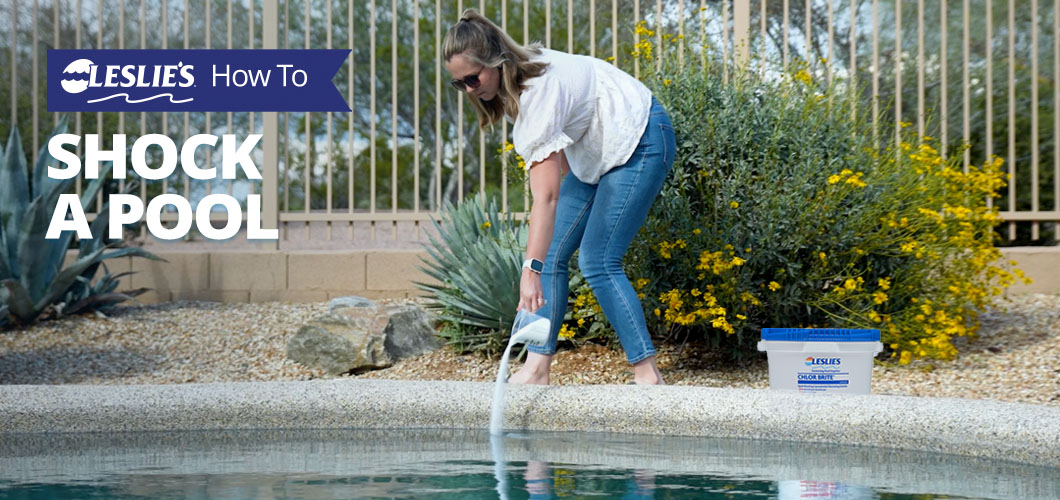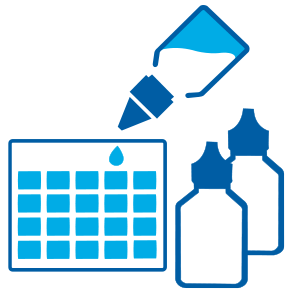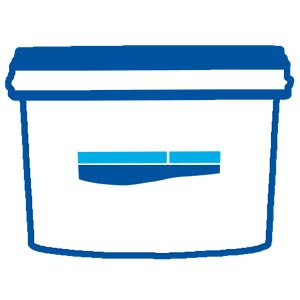
How to Shock a Pool
When it comes to pools, chlorine is a crucial part of maintaining healthy water. In addition to using a daily sanitizer, we highly recommend shocking the pool weekly to prevent algae growth, neutralize harmful microorganisms, and break down organic contaminants in the water. Before we discuss how to shock a pool, let’s explain why it's so important, and when to do it — including the best time of day and situations when shocking is required..
Shocking a pool is part of regular weekly maintenance during the warmer months. It's also done throughout the fall, winter, and spring, just less often while the weather is cool. Pool owners and pool service professionals shock a pool to “superchlorinate” the water. Shocking a swimming pool will destroy bacteria, control algae, and manage organic contaminants that regular chlorination may have missed.
Why Shock a Pool?
Chlorine levels fluctuate depending on the bather load, the amount of contaminants in your pool water, and the dosage of your primary sanitizer. Pool chlorine is engineered to attack and control bacteria, germs, and algae, so the pool stays safe for swimming. As the chlorine works its sanitization magic, it binds to ammonia in water from swimmers, fertilizers, bird droppings, sunscreen lotions, and more, forming chloramines. Chloramines are responsible for that strong, unpleasant, chlorine-like odor, and can cause skin, eye, and airway irritation. The only way to release this bound, inactive Combined Chlorine (chloramines) and continue sanitizing the water is to shock the pool.
DIY TIP: When pool or spa water is tested with a DPD test kit, there are three chlorine results that can be determined. Most colorimetric DPD test kits can test for Free Available Chlorine and Total Available Chlorine. Ideally, the Free and Total Available Chlorine results should be equal. When they’re not, the difference between the two levels determines the amount of Combined Chlorine in your pool.

When to Shock a Pool?
A regular weekly maintenance schedule involves shocking or oxidizing the pool water each week, using either a chlorine shock or a non-chlorine shock based on the tested levels of chlorine. For example, you might use a chlorine-based shock when chlorine levels are below 2 ppm. Then, when chlorine levels are above 2 ppm, use a chlorine-free shock to oxidize contaminants in the water.
So, when should you shock the pool? In general, shocking at night is best to allow your chlorine to work most effectively without having to fight against reactions caused by the sun's UV rays. Aside from the time of day, there are certain scenarios when it's necessary to shock a pool in addition to your weekly maintenance schedule.
When testing the water each week during swimming season, you will want to keep an eye on Free Available Chlorine (FAC) and Total Available Chlorine (TAC) levels. We’ll explain the different chlorine definitions in the next section. But these water test readings will guide your next steps, depending on the following shocking scenarios:
1. Rain & Thunderstorms
Following a big storm, heavy rain, and/or strong winds, your pool will likely be contaminated with dust, dirty rainwater, leaves, and other debris. Shocking after severe weather helps mitigate the effects Mother Nature may have on your pool.
BONUS TIP: We have an entire Resource Center series dedicated to helping you recover your pool after a weather event or any other scenario that brings dirt, debris, and other contaminants into your pool water. Whether you just experienced heavy rains, a hurricane, a haboob, or other major storm, we have everything you need in one place. Check out our Weather Events and Pool Recovery Category.
2. Opening & Closing
When opening your pool in the spring, we recommend shocking the pool after balancing the water chemistry. This will oxidize organic contaminants, control algae and bacteria, and can help in clarifying the water. When it's time to close your pool, shocking will help fight off germs and algae during the long winter months.
3. Algae Outbreaks
When algae appears in your pool, super-chlorination with powerful types of chlorinated shock, such as Power Powder Plus 73 or other variations of cal-hypo, can often eliminate the problem.
BONUS TIP: Need help clearing up an algae bloom? Looking for tips to prevent algae from happening in the first place? This article can help: How to Prevent and Remove Algae
4. Heavy Pool Usage
When many people use the pool in a short amount of time, the water becomes contaminated in many ways. Shocking after parties or other unexpected contaminations is highly recommended to keep the water sanitized.
5. Low/No Chlorine
If there's not enough chlorine in your pool, super-chlorinate the water with a chlorine-based pool shock (Power Powder Plus 73 or Chlor Brite) to get it back on track. It's important to make sure Free Available Chlorine and Total Available Chlorine levels stay within the ideal range of 1.0-4.0 ppm at all times to ensure proper sanitization.
6. Remove Chloramines
If your Total Available Chlorine (TAC) level is 0.3 ppm or higher above your Free Available Chlorine (FAC) level, it's time to shock the pool. This will break down the inactive Combined Chlorine (chloramines) in the water. The goal is for your FAC and TAC readings to be at the same level at all times.
When your FAC is between 2.0-4ppm, we recommend using a non-chlorine shock like Leslie’s Fresh 'N Clear to oxidize contaminants in the water and free up your FAC levels. Otherwise, use chlorine-based pool shock (Power Powder Plus 73 or Chlor Brite).
BONUS TIP: There's so much more to water balance than your chlorine levels! Learn more about water chemistry with Pool Chemistry 101, and learn about the ins and outs of balancing it with our article on How to Balance Pool Water.
7. Fecal Incident
If there's been a fecal accident or other unsanitary incident, close the pool for swimming. Remove as much debris as possible, and super-chlorinate the pool to kill off the germs and break down organic contaminants.

Types of Chlorine Test Results
Before shocking the pool, it's important to understand the different types of measurable chlorine, and why they're important in water chemistry and the health of your pool.
Free Available Chlorine
Free Available Chlorine (FC or FAC) is the effective chlorine that's active and available to sanitize your pool water. It's what breaks down contaminants to disinfect the water and control algae.
Combined Chlorine
Have you ever noticed that distinctive “chlorine smell” while visiting a public pool or water park? This strong, but memorable, scent is actually caused by inactive Combined Chlorine (CC), also known as chloramines. This happens when the chorine binds to ammonia in the water, and is an indicator that there may not be enough Free Available Chlorine present. As mentioned above, when chloramines are high, it's time to shock the pool.
Total Available Chlorine
Total Available Chlorine (TC or TAC) is the total amount of measurable chlorine in your pool. It's a total of both the Free Available Chlorine and Combined Chlorine present in the water. (FAC + CC = TAC)

Which Type of Pool Shock Should I Use?
Now, let’s discuss the different types of granular pool shock. When deciding which type of shock is best for your pool, keep a few things in mind.
There are three types of shock:
- Cal-Hypo (Calcium Hypochlorite)
- Dichlor (Dichloro-S-Triazinetrione)
- Chlorine-Free
Calcium Hypochlorite (Cal-Hypo Shock)
Also known as cal-hypo, calcium hypochlorite pool shock is a powerful and effective form of chlorine. It quickly destroys algae, bacteria, and other contaminants, and it's ideal for pools with a normal-to-low pH level because cal-hypo has a high pH level of 10.8. Cal-hypo also contains calcium, so it may not be ideal for pools with high Calcium Hardness.
Leslie’s Power Powder Plus 73 is great for a quick pool cleanup and chlorine boost when Free Chlorine levels are below 2.0 ppm. It is the strongest shock, providing 73% calcium hypochlorite with 70% available chlorine. Power Powder Plus 73 can be used weekly, but is also known as a solution shock because it is fast-acting and can destroy the toughest organic and inorganic contaminants. It is a great choice for post-party cleanup or to destroy algae blooms. Cal-hypo shock is ideal for pools that use 3" trichlor tablets as a primary sanitizer, because it won't add more Cyanuric Acid to the pool.
Dichloro-S-Triazinetrione (Dichlor Shock)
Called dichlor for short, dichloro-s-triazinetrione pool shock is stabilized, meaning it contains Cyanuric Acid (CYA). Using dichlor consistently will increase the residual CYA level over time. We don't suggest using this type of shock in an indoor pool, if your CYA levels are already elevated, or if you already use stabilized chlorine, such as 3" trichlor tablets, as your pool's primary sanitizer. This type of shock is ideal for saltwater chlorine generator systems or pools that don't rely on stabilized chlorine as a primary sanitizer.
When chlorine levels are below 2.0 ppm, using a maintenance shock like Leslie’s Chlor Brite can help boost chlorine levels with its 55% available chlorine content. It's a fast-dissolving solution that won't raise the pH level or cloud the pool water.
Potassium Monopersulfate (Non-Chlorine Shock)
This type is most commonly referred to as chlorine-free pool shock. Non-chlorine shock is great for quickly oxidizing organic contaminants and freeing up available chlorine. However, it will not kill germs or algae directly. In cases where you need to super-chlorinate the water, you wouldn't want to use this type of shock. This type of shock will improve water clarity and complement enzyme treatments for breaking down non-living organic contaminants in the water. In addition, it won't impact your water's pH. It's a fast-dissolving, fast-acting shock that allows you to resume swimming in 15 minutes or less.
A non-chlorine variety of shock, such as Leslie’s Fresh 'N Clear, is perfect for weekly use when Free Chlorine levels are in the 2.0-4.0 ppm range. Fresh 'N Clear oxidizes and destroys ammonia and non-living organics, helps clear up cloudy water, and can prevent chloramines to keep your Free Chlorine and Total Chlorine at the same level. It works great in all pool types, no matter which primary sanitizer you use.

How to Shock a Pool
Step 1. Test the Water
Using a water test kit or test strips, ensure that all aspects of water chemistry are within the proper range. Use non-chlorine shock if your Free Available Chlorine level is between 2.0–4.0 ppm, and use a chlorine-based shock if levels are below 2.0 ppm.
Step 2. Circulate the Water and Add Pool Shock
Turn on your pump and filter system to circulate the water. Then, following product label instructions for application, pour your shock around the inside perimeter of your pool. The best time to shock is at dusk or evening hours, so you can let your pump run overnight. Shocking the pool at night allows the shock to work most efficiently, without the sun burning off the chlorine quite as fast.
Step 3. Wait for FAC Level to Drop
If using a chlorine-based shock, continue letting the pump run for at least 6–12 hours, then retest the water. The Free Available Chlorine (FAC) level may still be very high, making it unsafe to swim.
Step 4. Enjoy Clean, Safe Water
Wait until the FAC level falls within the ideal range of 2.0–4.0 ppm before jumping back in the pool. Now, go enjoy your clear, clean, and safe swimming pool!
Bonus Videos
Learn more about the importance of shocking a swimming pool by watching these helpful videos: